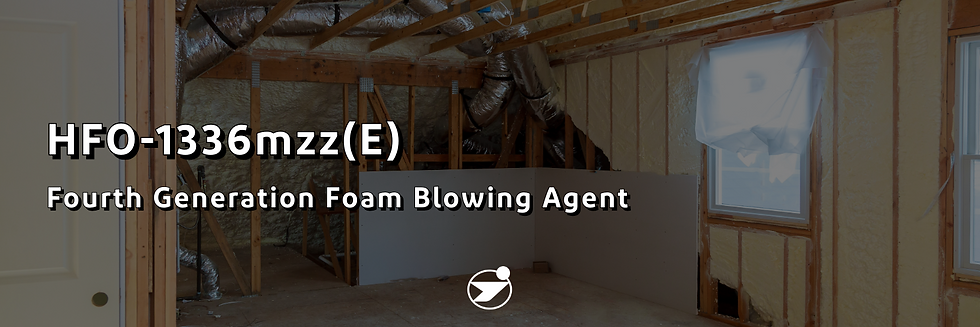
Understanding Foam Blowing Agents
Blowing agents, also known as foaming agents, play a crucial role in generating cellular structures within various materials undergoing phase transitions or hardening processes, such as polymers, plastics, and metals. These agents find applications across diverse industries including building insulation, automotive, furniture, packaging, and firefighting equipment. Typically, blowing agents exist in liquid or gas form, dissolved in foam precursors, and expand to form foam upon injection or spraying during the foaming reaction. Particularly, they are indispensable in spray foam insulation, commonly installed within the walls of residential or commercial structures. However, traditional blowing agents have raised environmental concerns, necessitating a shift towards eco-friendly options such as foam blowing agents based on HFO chemistry.
Evolution of Foam Blowing Agents: From CFCs to HFOs
The journey of foam blowing agents has seen significant evolution, marked by continuous refinement and innovation. Initially, chlorofluorocarbons (CFCs) constituted the first generation of blowing agents, but their detrimental environmental impact led to their prohibition in the 1990s due to high Global Warming Potential (GWP) and Ozone Depletion Potential (ODP). Subsequently, hydrochlorofluorocarbons (HCFCs) emerged as the second generation, only to face similar regulatory measures owing to their adverse effects. Hydrofluorocarbons (HFCs), the third generation blowing agents, are currently undergoing phase-out due to their substantial contribution to global warming. In contrast, the latest advancement comes in the form of fourth-generation alternatives, namely HFOs, which offer superior environmental attributes. HFOs, characterized by zero ODP and low GWP, have garnered popularity in various industries, including foam insulation, aligning with international agreements such as the Paris Agreement and the Kigali Amendment of the Montreal Protocol.
Why HFO Alternatives Prevail Over HFCs?

Hydrofluoroolefins (HFOs), distinguished by their low GWP and ODP, represent a significant advancement in foam insulation technology. These unsaturated organic compounds, comprising hydrogen, fluorine, and carbon, are gaining traction for their extensive applications beyond insulation, including refrigeration, aerosols, and specialty working fluids. The key differentiator between HFOs and HFCs lies in the presence of an olefin, signifying a double carbon bond within the molecule. This structural feature renders HFO molecules more environmentally friendly, as they exhibit a brief atmospheric lifespan, decomposing rapidly and thereby minimizing their environmental impact. This attribute makes HFO blowing agents a crucial component in mitigating climate change, in the building and construction materials sector.
The Performance of HFO Chemistry in Foam Insulation
HFO chemistry plays a pivotal role in enhancing the performance of foam insulation, thereby contributing to energy efficiency and environmental sustainability. Effective insulation reduces heat transfer, thereby improving energy efficiency, enhancing occupant comfort, and potentially reducing energy costs. Whether in new construction or retrofitting existing structures, superior insulation, fueled by HFO chemistry, can significantly reduce energy consumption and greenhouse gas emissions, offering long-term benefits to both individuals and businesses.
Applications Utilizing HFO Blowing Agents
Yuji's HFO-1336mzz(E) and other high-performing HFO chemicals empower the creation of insulation foam and foam products, enabling builders and roofers to achieve energy efficiency goals, cost savings, and reductions in greenhouse gas emissions. By providing comparable or superior performance with substantially lower GWP compared to alternatives utilizing HFC blowing agents, HFO solutions offer a more sustainable choice across various applications, including:
- Spray Foam Insulation
- Rigid Polyurethane Foam
- XPS Foam Products
Partnering with Yuji for Sustainable Solutions
In an era of heightened environmental awareness and regulatory scrutiny, industries reliant on spray foam, adhesives, and insulation are compelled to prioritize sustainability. Yuji collaborates with industry leaders and manufacturers to develop next-generation chemical solutions tailored to meet evolving environmental standards. Our extensive product line of blowing agents with low greenhouse effect index supports the industry's transition to sustainable alternatives, reaffirming our commitment to environmental stewardship and societal well-being.
As industries embrace sustainable alternatives, the significance of HFO chemical solutions is poised to rise. Yuji's HFO blowing agents, distinguished by their excellent performance qualities and low greenhouse effect index, stand as ideal choices for product development, driving the transition towards a greener and more sustainable future.






コメント